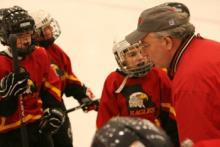
The night was November 3, 1999, and the final seconds were ticking down in a junior varsity hockey game between bitter local rivals, New Trier High School and Glenbrook North High School, at the Rinkside Sports Ice Arena in the Chicago suburb of Gurnee. New Trier was comfortably ahead, 7-4, in the teams' first encounter since Glenbrook North had edged them, 3-2, for the Illinois state junior varsity title a season earlier.[1] Junior varsity contests do not normally provide lasting memories in any sport, but this early-November game would be different.
The early-November rematch painted a grim picture. “[V]iolence flared repeatedly as the mood grew ugly” from the opening faceoff, [2] and eyewitnesses later described “an intense battle” [3] as each team‟s parents and students taunted rival fans and players. [4] Players themselves traded taunts and squared off in altercations unrestrained by their coaches, [5] the leaders recognized by pediatric professionals as “the most important individual[s] for maintaining safety” in youth leagues. [6] One coach reportedly even left the bench and strode onto the ice during the game to confront a referee. [7] The Glenbrook North coach allegedly “rallied his players to take special action” against New Trier‟s 15-year-old sophomore co-captain Neal Goss, whose three goals helped seal the victory. [8] The referees called sixteen penalties, [9] a particularly high number for a junior varsity hockey game.
At the final buzzer ending the contest or within a second or two afterwards, a 15-year-old Glenbrook North player skated full speed across the ice, blind-sided Goss, and body-checked him head-first into the boards. [10] “That‟s what you get for messing,” the player allegedly said as Goss lay prone on the ice, permanently paralyzed from the neck down. [11]
Neal Goss‟ catastrophic spinal cord injury introduces my two conclusions, drawn from my experiences as a lawyer for thirty-five years, and as a volunteer youth-league and high school hockey coach concerned about player safety for more than forty. Both conclusions concern injury prevention, the first obligation of parents and coaches who conduct and supervise games for the estimated twenty-five to thirty million boys and girls who participate in organized sports leagues each year. [12]
First, we should not exaggerate the law's role in preventing avoidable injury to “youth leaguers” -- players in sports events conducted by public or private schools, private organizations, or public agencies such as parks and recreation departments. Americans often look to the law for enforceable standards to help govern personal behavior, but (as I discussed in Part II of the attached law review article* discusses in detail, the law provides youth leagues only limited protection because the legal process is essentially reactive and proactive. A civil damage action and a criminal prosecution followed quickly from Neal Gross' injury, but neither proceeding did anything to prevent lifelong paralysis.
Second, the protection afforded by national safety standards established by safety experts -- equipment designers, physicians' groups, and youth sports governing bodies – is similarly limited because as Part III of my 2012 Seton Hall law review article discusses, parents and coaches behaving irresponsibly can neutralize these standards and put the players in harm‟s way in a few moments. Protective equipment is designed and playing rules are conceived with sound medical advice at the national level, but young athletes wear equipment and compete at the local level.
For years now, national youth sports governing bodies (USA Hockey, US Youth Soccer, the American Youth Soccer Organization, and others) have influenced local behavior through adult-education programs that emphasize sportsmanship and mutual respect among competitors and their families. Posters, videos, DVDs, brochures, website entries and similar materials provide the framework for mandatory parent meetings often conducted by local leagues or teams, usually during the pre-season period.
For good reason, these materials typically cast parents and coaches as role models for the players they raise and supervise. Youth leaguers are not born with attitudes about sportsmanship and respect but, like other children, learn what they watch over time. They react not only to media reports of excesses in professional sports, but also to the verbal and non-verbal cues passed by their parents and coaches, the most influential adults in their athletic lives. Adults carefully watch the children as they play organized sports, but children also watch the adults.
Sportsmanship and mutual respect indeed teach children citizenship, but they do much more than that. Adherence to sportsmanship and mutual respect can also help prevent many avoidable injuries that may disrupt and even devastate the lives of young athletes and their families. If adults committed to these two virtues had guided the New Trier-Glenbrook North JV hockey game, Neal Goss would likely have walked out of the rink that night because sportsmanlike, respectful teens trained by responsible adults do not blind-side opponents and drive their heads into the ground at the end of a game.
From my years of coaching, I sense that adult-education materials created by national youth sports governing bodies do successfully influence many adults to embrace sportsmanship and respect. More work, however, needs to be done. According to a 2010 poll conducted in twenty-two nations by Reuters News and the market research company Ipsos, parents in the United States still rank as the world‟s “worst behaved” parents at children‟s sports events.[13]
As they seek new ways to influence adult attitudes, youth sports governing bodies should combine the time-tested and assuredly valuable citizenship-based “role model” message with safety-based messages that prominently and directly identify sportsmanship and respect as an injury-prevention strategy. When sportsmanship and respect prevail, children striving to win are less likely to suffer injury.
New safety-based messages may strike a receptive chord by reminding parents and coaches that danger does not discriminate. Neal Goss was simply in the wrong place at the wrong time, a victim of an opponent‟s impetuous violence. The victim lying paralyzed on the ice at the end of the New Trier-Glenbrook North hockey game could have been any parent‟s child because the volatility that adults encouraged or tolerated throughout the contest had already deprived every player of the safety provided by protective equipment and carefully-crafted national safety standards.
Because avoidable injury arising from local abandonment of sportsmanship and respect so often strikes youth leaguers at random, maintaining safety during games and practice sessions remains every family‟s concern. In Part III of my law review I discuss why youth sports governing bodies would serve the teaching procoess best by coupling existing citizenship-based messages with a strong, clear, prominent new message that also stresses injury prevention to sensitize parents and coaches to a straightforward formula: Sportsmanship + Respect = Safety.
Parents and coaches who watched Neal Goss lifted from the ice rink on a stretcher that cold November night doubtlessly wished that they could have turned back the clock and scripted a different ending. The story would have had a much happier ending – indeed, there would be no story worth remembering at all -- if the young hockey players had been protected not only nationally by equipment and safety standards, but also locally by adherence to sportsmanship and respect that help insure safe, spirited athletic competition.
1. Megan O’Matz, Teen Charged With Battery in Hockey Hit: Intent to Injure Is Cited: Foe Paralyzed From Check, CHI. TRIB., Dec. 8, 1999, at 1; Scott Stewart, Emotions High Before Hockey Tragedy, CHI. SUN-TIMES, Dec. 9, 1999, at 1.
2 Associated Press, Hockey Charge Reduced: No Contest: Illinois Prep Enters Plea, TELEGRAPH-HERALD (Dubuque, Ia.), Aug. 8, 2000, at B1
3 Debbie Howlett, Teen May Face Trial In Sports Injury, USA TODAY, May 5, 2000, at 3A.
4 Associated Press, Hockey Charge Reduced, supra note 2, at B1; see also, e.g., Scott Stewart, supra note 1, at 1; Debbie Howlett, supra note 3, at 3A.
5 Scott Stewart, supra note 1, at 1; Richard Roeper, Decatur Fight Child’s Play Next to Hockey Violence, CHI. SUN-TIMES, Dec. 13, 1999, at 11.
6 Charles H. Tator et al., Spinal Injuries in Canadian Ice Hockey: An Update to 2005,19 CLIN. J. SPORT MED. 451, 455 (2009).
7 Locking Juvenile Up Piles One Tragedy Atop Another, STATE J.-REGISTER (Springfield, Ill.), Dec. 10, 1999, at 31.
8 Megan O’Matz, Hockey Suit Detailed: Family Seeks Damages, CHI. TRIB., Dec. 9, 1999, at 1.
9 Rummana Hussain, Probation For Teen Who Delivered Hockey Hit, CHI. TRIB., Oct. 27, 2000, at 1.
10 Tony Gordon, Plea Deal Ends Emotional Hockey Case, CHI. DAILY HERALD, Aug. 8, 2000, at 1; Debbie Howlett, supra note 3, at 3A.
11 Dirk Johnson, Hockey Player, 15, Is Charged After Seriously Injuring a Rival, N.Y. TIMES, Dec. 9, 1999, at A21; Megan O’Matz, Hockey Suit Detailed, supra note 8, at 1.
12 See, e.g., TOM FARREY, GAME ON: THE ALL-AMERICAN RACE TO MAKE CHAMPIONS OF OUR CHILDREN 16 (2008); Glyn Roberts, Motivation in Sport: Understanding and Enhancing the Motivation of Children, HANDBOOK OF RESEARCH ON SPORT PSYCHOLOGY, 405, 411 (Robert N. Singer et al. eds., 1993).
13 ABC News, U.S., India Parents Seen as Worst Behavedat Kids' Sports (Apr. 10, 2010).
*This article is adapted from Abrams, Douglas E. (2012) "Player Safety in Youth Sports: Sportsmanship and Respect as an Injury-Prevention Strategy," Seton Hall Journal of Sports and Entertainment Law: Vol. 22: Issue 1, Article 1. To read the full law review article, click on the link to the attachment below



